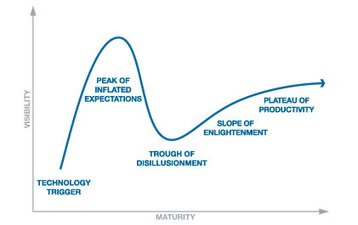Last November at DatacenterDynamics London I took part in a panel discussion “If hype killed DCIM, what next?”. Reports of its death were clearly exaggerated because last week the show’s organisers published an editorial item, “Is DCIM finally real?” It’s good that high profile content providers continue to ask probing questions about the technology, because, let’s face it, a lot has been promised about DCIM in recent years, between analyst forecasts and manufacturers’ promises.
So you might be wondering what happened and why the prospects for DCIM are still being put under the microscope? I think that Gartner’s Hype Cycle perfectly charts the way the story has developed. Let’s start at the beginning when DCIM seemed to explode onto the scene as a result of a focused Innovation Trigger; the need to monitor data center power and cooling capacity so that availability and efficiency could be maximised. PUE being the high profile metric by which data centers were being both evaluated and marketed.
In my experience the market then moved very quickly up the Hype Cycle to reach the Peak of Inflated Expectations. The technology was touted as a cure-all, and more and more data center “customers” began to look to the potential of DCIM to solve their challenges. From network and finance managers to IT and facilities operations professionals, expectations were unilaterally high. And all this literally happened over a period of 18 months to two years.
Then the trouble started to get compounded. More and more diverse applications were consolidated under the DCIM banner. This proliferation of features on the solutions side was coupled with a lack of understanding of the real impact and requirements which would be placed upon the customer’s team - such as an inclusive change management process and the substantial instrumentation required to collect data and make DCIM an effective tool.
At Uptime, a speaker from CenturyLink spoke about exactly these things. The stark advice to those embarking on a DCIM project, whatever your budget, it’s twice that. Whatever time you think it will take, it’s twice that too. Having worked with numerous DCIM users in colocation and service providers, enterprise and SMB data centers, I think I can honestly say that it’s a wicked hard path.
So you’ll be unsurprised to read Gartner’s been saying since 2013 that the DCIM market is mired in that special place they call the Trough of Disillusionment. With so many high expectations apparently unmet, where are we today and what has been changing to make it easier for those responsible for facilities to take advantage of the rich functionality and operational advantages which DCIM can provide? What, particularly can help sweep us up the Slope of Enlightenment?
I think that the first thing which is almost willfully being overlooked is the evidence that DCIM works. Nobody denies it’s a long and difficult journey (have a look at the Sky case study published on the DatacenterDynamics website), but the companies which have set out on it are seeing definite returns. What’s more, it’s a long list of users which includes educational establishments, enterprise businesses, colocation companies and other service providers. From the very high profile – CenturyLink, Sky – to those only famous in their backyard, like Cardiff University.
Secondly, the market is maturing; both customers and manufacturers are more experienced and better informed. Expectations being set are more realistic. This is not to say they’re being lowered, simply that targets are far less aggressive. It’s interesting that in the UK, where those running infrastructure at Universities can get investment on the basis of “greening” their environments, we have an increasing base utilizing DCIM to prove the value of efficiency upgrades as they are deployed. In other data centers we see a range of drivers not specifically geared to ROI, such as reputational concerns or productivity gains.
Thirdly, as one of the leading DCIM providers according to Gartner, we’re constantly looking at the simplification of the solutions; from specification, installation, configuration and rolling out the system, to patching, maintenance and continuous improvement of the applications and the actionable information provided. And naturally, we’re looking at how this could be provided as a service; cloud-enabling the tools and taking this burden off the data center operations team so they can focus on their real objectives.
I’m not going to address the question raised about larger service providers building their own DCIM. Suffice to say, our colocation customers are trusted because they are specialists in operating data center infrastructure for maximum reliability, efficiency and cost-effectiveness – but probably not for their reputation as software developers. If you’re interested to find out more, you can see my comments about DIY DCIM solutions on this filmed blog.
Is DCIM finally real? It’s been a real thing since the category was first defined. What’s changed is that we’re looking beyond using the software to help with the perennial drivers for data center investment (according to DatacenterDynamics Intelligence – the company’s own market research organisation) and towards operating in a holistic fashion based upon real data. In their research findings, as in our in our commercial experiences, the Plateau of Productivity is in sight.


